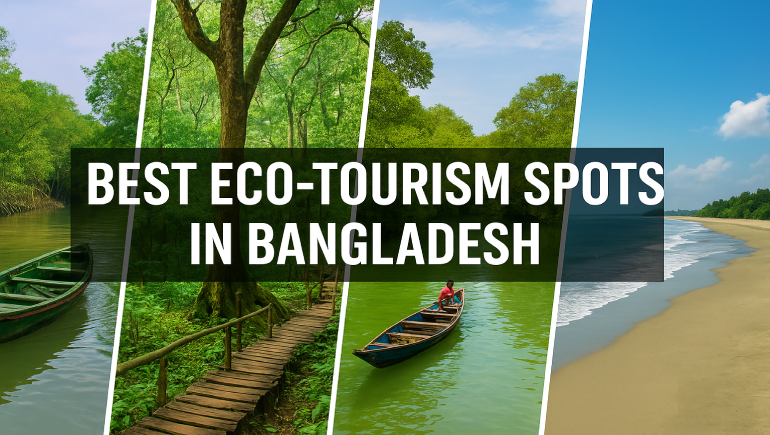
Bangladesh is a land of vibrant landscapes, rich biodiversity, and unique cultural heritage. Beyond its bustling cities, the country offers pristine eco-tourism destinations that allow travelers to connect with nature while promoting sustainable travel. Whether it’s serene forests, tranquil rivers, or breathtaking wetlands, Bangladesh has plenty of eco-friendly escapes for nature lovers.
The Sundarbans is the largest mangrove forest in the world and a UNESCO World Heritage Site. Located in the southwestern part of Bangladesh, it spans over 10,000 sq km and is home to the majestic Royal Bengal Tiger, salt-tolerant trees, and diverse wildlife. Visitors can explore by boat, experiencing guided eco-tours that focus on preserving the delicate ecosystem. The Sundarbans offers a truly immersive experience for eco-conscious travelers.
Eco-Tourism Tip: Choose certified local tour operators who follow sustainable practices and avoid disturbing wildlife.
Situated in Sylhet, Lawachara National Park is a lush tropical rainforest covering around 1,250 hectares. Known for its rich biodiversity, it is home to endangered species such as the hoolock gibbon, macaques, and various bird species. Eco-tourists can trek through well-marked trails, visit observation towers, and enjoy the peaceful sounds of nature.
Best Time to Visit: October to March, when the weather is pleasant and wildlife sightings are frequent.
Ratargul is one of the few freshwater swamp forests in Bangladesh and offers a unique eco-tourism experience. Located in Gowainghat, Sylhet, the forest floods during the monsoon season, creating an enchanting water-bound forest. Visitors explore Ratargul by boat, gliding through still waters surrounded by lush greenery.
Highlight: The serene boat rides make it a perfect spot for eco-friendly photography and birdwatching.
Kuakata, also known as the "Daughter of the Sea," is famous for its panoramic views of both sunrise and sunset over the Bay of Bengal. This beach destination promotes eco-tourism through sustainable beach practices and local community engagement. Tourists can enjoy clean beaches, local seafood, and eco-friendly homestays.
Eco-Tourism Tip: Support local businesses and avoid single-use plastics to help preserve Kuakata’s natural charm.
Nestled in the Chittagong Hill Tracts, Sajek Valley offers stunning landscapes of rolling hills, cloud-covered peaks, and tribal culture. Known as the "Queen of Hills," Sajek promotes eco-tourism through responsible tourism initiatives. Visitors can hike, explore local villages, and enjoy scenic views without harming the natural environment.
Best Time to Visit: October to April for a cool climate and crystal-clear views.
Hakaluki Haor in Sylhet is one of the largest wetlands in Asia, offering a unique eco-tourism experience. This biodiversity hotspot is home to migratory birds, freshwater fish, and rare plant species. Boat tours and guided nature walks allow visitors to explore this delicate ecosystem while learning about its importance in maintaining environmental balance.
Highlight: The wetland offers incredible birdwatching opportunities, especially in winter.
Eco-tourism not only allows travelers to enjoy nature’s beauty but also supports conservation efforts and benefits local communities. By visiting eco-tourism spots, you help preserve ecosystems, promote sustainable livelihoods, and protect biodiversity.
Bangladesh’s eco-tourism destinations are a treasure trove for nature enthusiasts. From the sprawling Sundarbans to serene swamp forests, scenic hills, and pristine beaches, the country offers an enriching travel experience that benefits both travelers and the environment.
Whether you are seeking adventure, peace, or cultural immersion, Bangladesh’s eco-tourism spots promise unforgettable journeys while encouraging sustainable travel.












Comments
There are no comments for this Article.